Iron Age gold hoards
At Grönsö, south of the Viking town of Birka, Anders Lund is said to have found in 1874 two massive arm rings bound together with a rod, exposed in an upturned tree root. The gold find weighed 528.6 grams, and he received 1,425 riksdaler in compensation.
The findspot was questioned in the 1930s, when villagers claimed that Anders Lund had instead discovered the treasure within the town area, Svarta jorden, where he was participating in Hjalmar Stolpe’s excavations. He had been unable to show the findspot, even though it was on his own land, and suspicion arose that he had fraudulently claimed the redemption money, which would not have been paid had the find been made during an ongoing excavation.
The location of the large silver hoard, however, is known. It contained around twenty complete objects and 450 Arabic and Byzantine coins. The silver lay on an iron tray, which a labourer lifted with his spade while digging a trench north of the village road. It was deposited in the ground no earlier than around AD 960.

The Grönsö rings
On view at Historiska museet in the exhibition Guldrummet
The Frustuna pendant
This half-moon-shaped pendant of filigree wire and granulation beads is unique. Its unusually long, movable loop fits an earring. But how was the hoop fastened to the ear?
Nordic women did not wear earrings, but Slavic women in continental Europe did. The hoops attached to the earlobe on those were two-part. Fragments of Slavic filigree earrings occur as scrap silver in Viking Age hoards on Gotland. There has even been speculation as to whether the piece could be modern.

Pendant
Spiral hooks ending in small beads are a stylistic feature found on high-quality metalwork in Western Europe during the Viking Age. Here, the smith has tried to incorporate them into the crescent form, which in fact belongs to an eastern stylistic tradition.
A gold bracteate
A bracteate is a type of pendant made of bronze, silver, or gold. Bracteates vary in appearance, sometimes resembling coins, sometimes more like a thin, round disc with abstract designs.
The bracteate from Gane farm, about twenty kilometres east of Visby, was discovered in 1836 by an unknown ditch-digger. It lay beneath or beside an upright grey stone. At the same spot the digger also found two arm rings and a silver arm band, another bracteate, a glass bead, and a Roman coin.
The coin bears the profile portrait of the empress Crispina Augusta, and was therefore struck sometime between AD 178 and 191. The bracteates themselves belong to the Vendel period, roughly AD 550–750. More often, bracteates tend to date to the earlier Migration period.
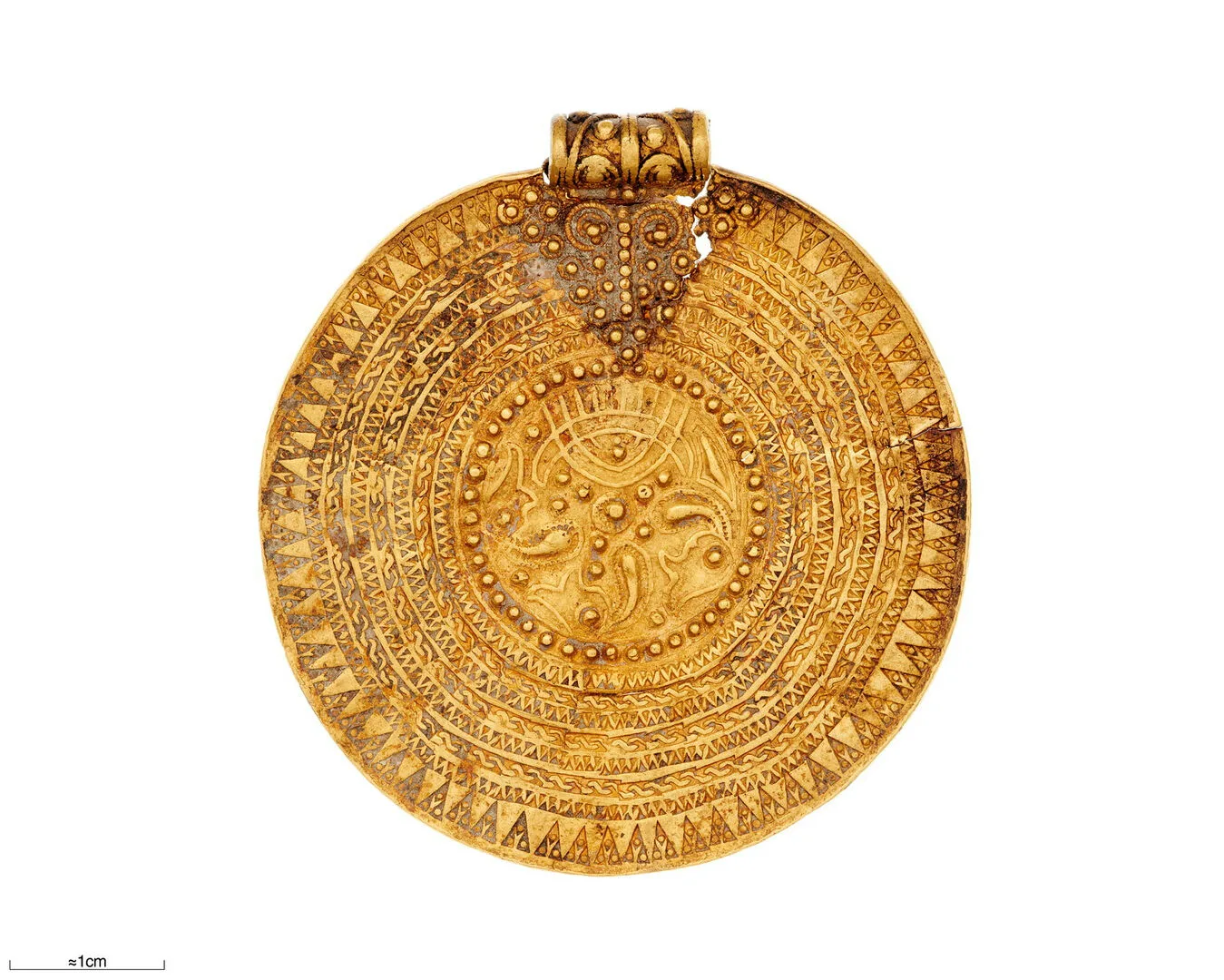
Bracteate
Found on Gotland.
On view at Historiska museet in the exhibition Vikingarnas världFind this object in display 19, Vikingarnas värld Monter 19
Whether the finds were placed there as a votive offering or hidden as a way of concealing valuables, we cannot know. The upright stone may indicate that the person who placed the items there wanted to mark the spot, either to find it again, or to manifest the place in the landscape.
The gold foil figures from Bolmsö
In 1911, two gold foil figures, each 1.5 centimetres high and struck from the same die, were found in a cremation grave. They are the only examples in Scandinavia where the millimetre-thin gold sheet has been folded around a bronze sheet, which also had a hole, enabling the figure to be worn as an amulet.
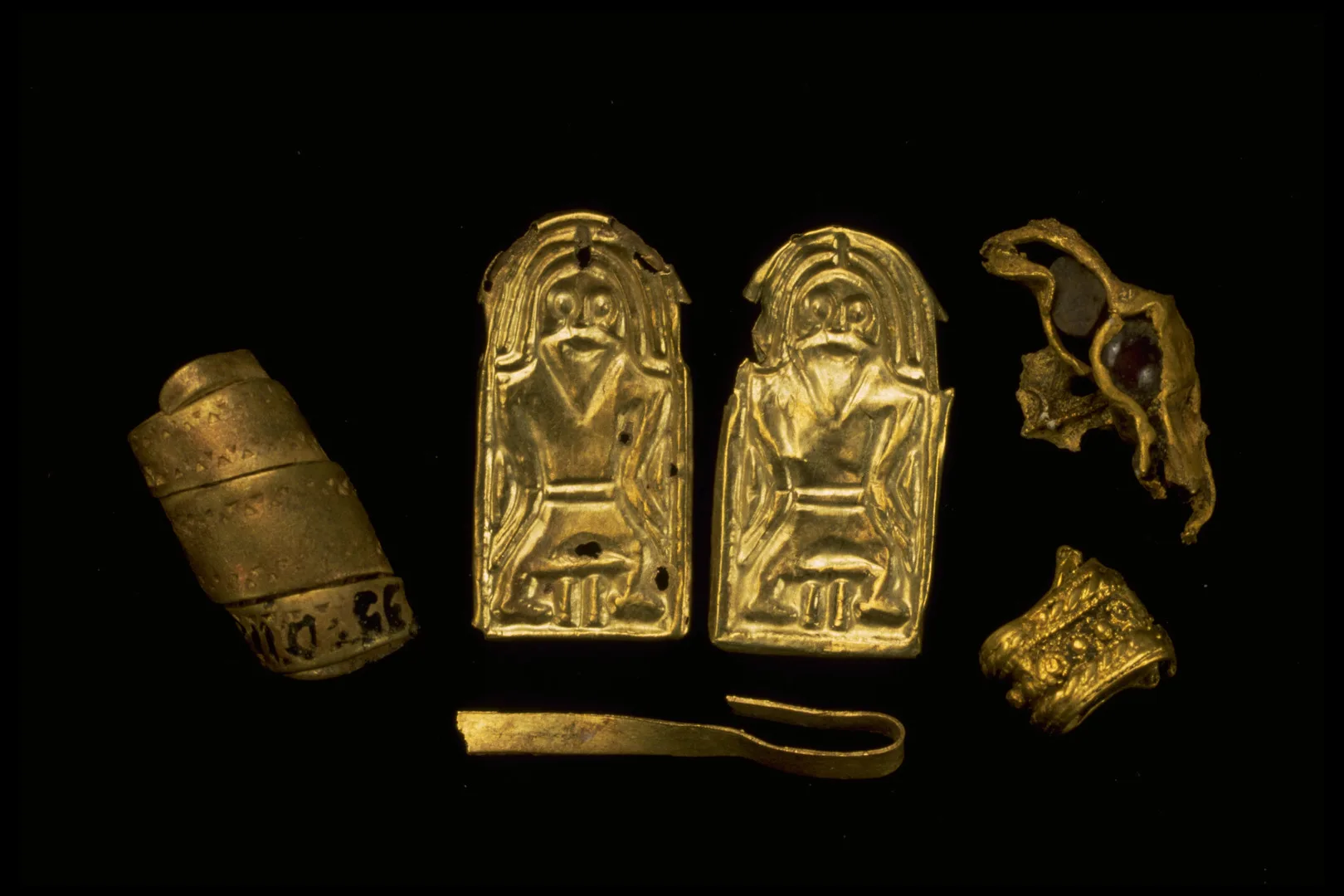
Gold foil figures from Bolmsö
The figure could represent the fertility god Freyr seated in the high seat, here shaped as a simple stool. Other gold foil figures may show a loving couple, a motif sometimes found in buildings believed to have been used for cult purposes.
Among the grave fragments were a rounded garnet setting from a precious object, a stamped foil bead, and a loop from a bracteate.
The gold collar from Möne
Västergötland’s largest neck-ring was discovered in 1864, when crofter Johannes Andersson cleared a cairn. It has seven coils and weighs 823 grams. Possibly it was a collar for a heathen priest, a goði.
Icelandic sources tell us that the goði had religious as well as judicial and political responsibilities. The word goð means deity. The hofgoði, or temple-priest, presided over sacrifices at the cult temple and administered justice at the assembly. There the gods were witnesses, ensuring that law and justice were upheld.
Some chieftains may thus have been perceived as representatives of the gods, and on such occasions may have worn collars like this one.

Gold neck-ring
On view at Historiska museet in the exhibition Guldrummet
Arm rings from Torhamn
In 1829 four arm rings were found in Torhamn, Sweden. Two were redeemed the same year, while the other two entered the museum when the private collector M. Söderström donated his collection in 1848. Together the arm rings weigh 216 grams.
Arm rings closed with rhomboid plates and decorated with simple stamped motifs also appear in the hoard from Peenemünde in Pomerania, on the opposite side of the Baltic. Four similar arm rings have also been found in Västra Stenby parish in Östergötland.
The arm ring was a man’s ornament. The sagas tell us that they were exchanged as gifts between great men as a confirmation of loyalty.
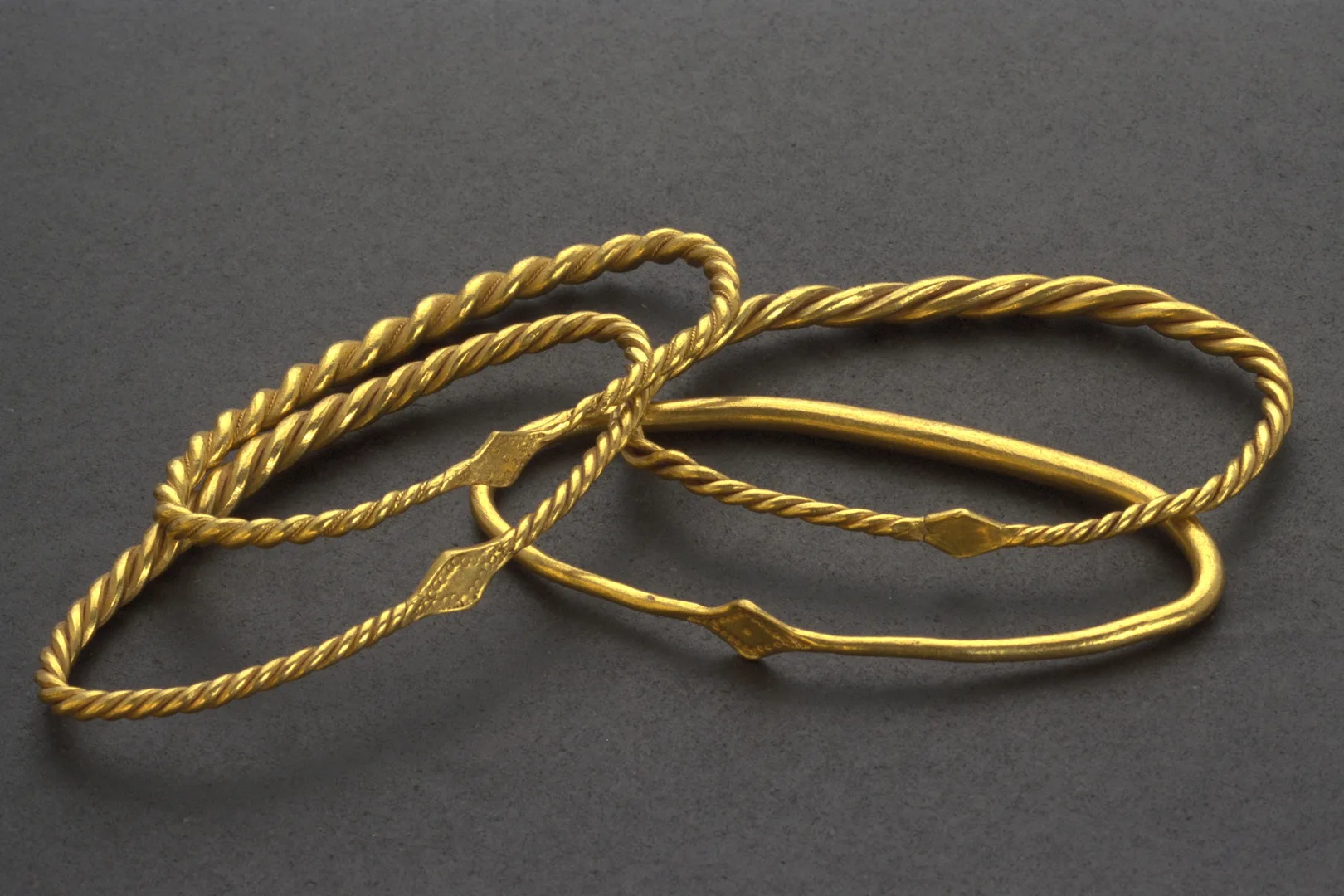
Arm rings from Torhamn
Brooch from Kastlösa
Gold dress brooches were rare in the Viking Age. As gold was scarce, it was usually used to gild bronze ornaments or to decorate them with small filigree plates. The Kastlösa brooch is the only known example in gold.
Dress fastenings, with their particular arrangement of brooches, were, with the exception of Gotland, highly standardised for Scandinavian women. Oval brooches were fixed to the straps of the pinafore dress. The cloak or jacket, worn as an outer garment, had its own third brooch.
The Kastlösa brooch probably served, like bronze brooches of the same size, to fasten the slit at the neck of the linen underdress worn beneath the woollen gown.
It was discovered in 1889 by the juryman J.A. Dahlgren.
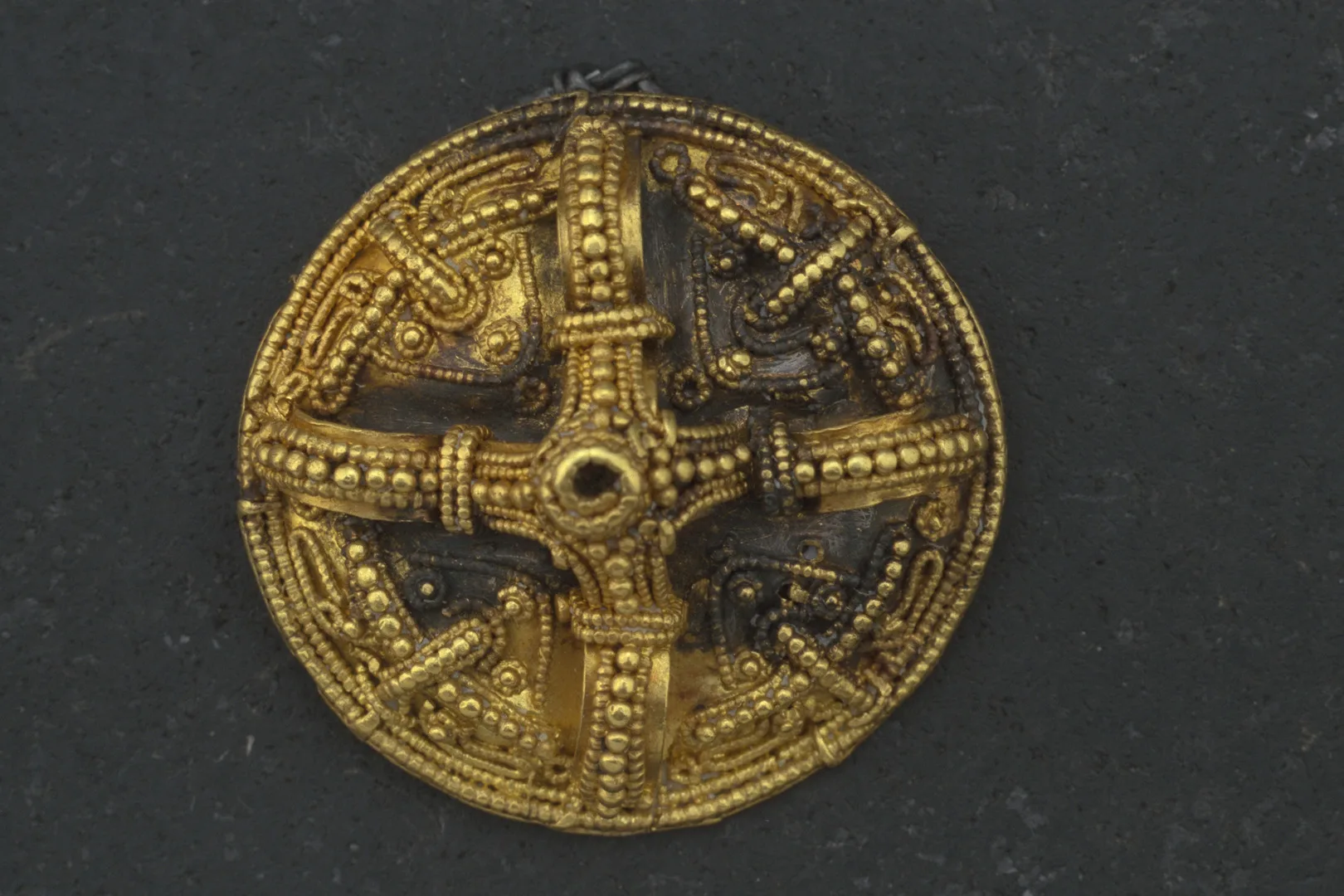
The brooch from Kastlösa
The Gillberga gold offering
In 1924, schoolboy Per Adolf Andersson was fishing by the River Byälven in south-western Värmland when he noticed something glittering in the riverbed.
He had found a bundle of pure gold weighing 127 grams. At the centre of the bundle was a scabbard chape made from a spiral rod coiled four times. At its ends were spiral rods known as payment gold, and a finger ring of spiral gold wire. In addition, four small round pendants decorated with gold granules were attached.
All of it can be dated to about AD 400–550, and must once have belonged to a local chieftain. Chieftains and kings of this time were often referred to as ring-givers, meaning that they gave out gold rings to bind men to themselves. The gold is probably a treasure offered to the gods.
At first, the boy’s parents did not believe the find had any value, so he said nothing about it. Later, the secretary of the local heritage society arranged for the treasure to be redeemed, and the boy received 355 kronor in compensation. Today, that corresponds to between 10,000 and 100,000 kronor, depending on how it is calculated. It was indeed a great catch in 1924.
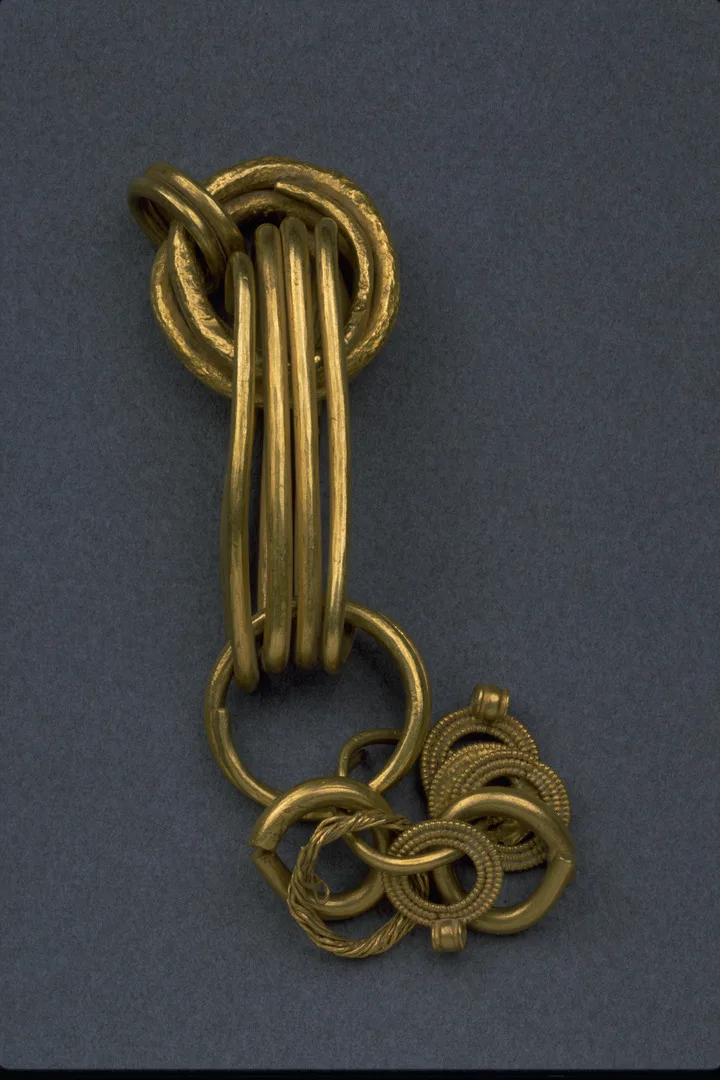
Gold rings
On view at Historiska museet in the exhibition Guldrummet





